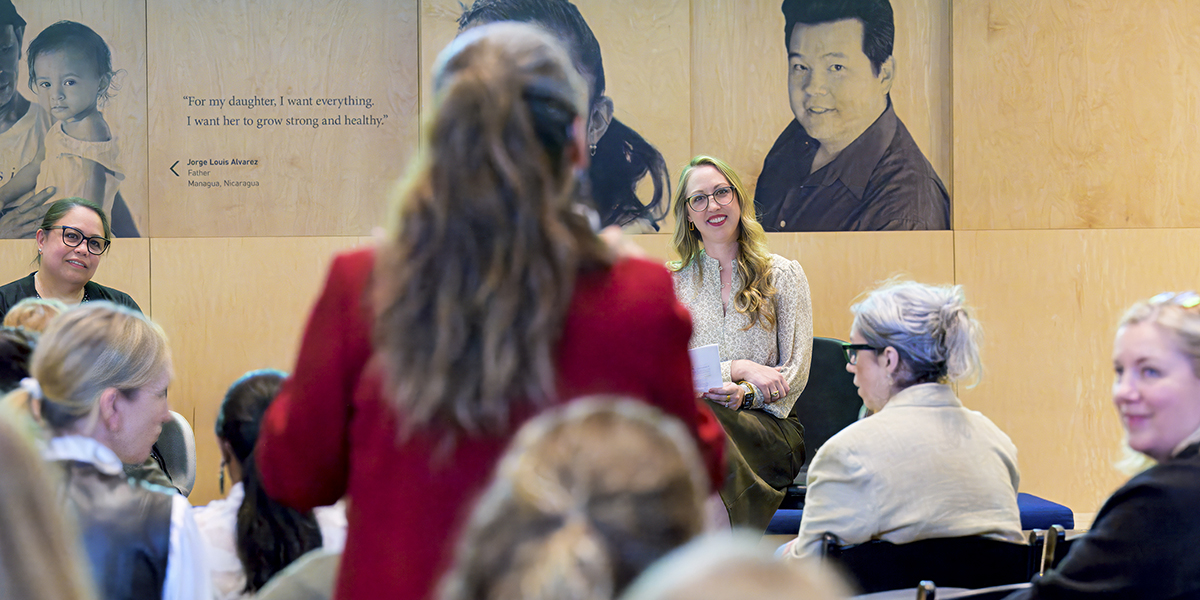A leader’s work is timed to a drumbeat. We are consistently evaluating whether our organizations are operating in the right model, with the right capacity, dedicated to the right business outcomes. The modern workplace demands agility, yet the prevailing workforce design mentality is decades old. Employee hiring and headcounts are still touted as an indicator of an organization’s success or health. The pattern that follows is re-org, right-size, hire, re-org…
Consider what your team could achieve if we broke the cycle and re-imagined your workforce. A blended model – one that consistently considers flexible talent in strategy and planning – operates as an accelerator for innovation and an employee retention driver. With a blended workforce model, you gain greater control of your talent budget, business agility, and the opportunity to invest deeply into employees who will lead your organization forward.
We have had choice and flexibility in how we hire for years – contractors, vendors, suppliers, freelancers – these are not new talent solutions. However, leaders often get stuck understanding when and for what roles we should insource (hiring employees) vs. outsource (contract talent).
4 times you can outsource an executive or leader
As the US continues to experience a growing independent workforce, high-earners and senior leaders are carving out their own niche in the independent talent pool. Thirty-two percent of independent workers identified as high-earners (>$150K annually) and 45% indicated that they had an advanced degree in a McKinsey study.
Senior leaders, like many independent workers, opt out of the employee workforce for the autonomy and flexibility of contract engagements after years of working their way up in organizations. By opting into independent work, leaders can control how much, for whom, and on what projects they work.
- Market validation & start-up phases. If you’re like me, and every other start-up veteran out there, you’ll remember when “employee #196” meant some kind of elevated social status – pre-Series B, C & D, pre-IPO. Here’s what else it meant- pre-layoff, pre-pivot 1,2,3 and 4. In periods of market validation or start-up phases, consider tapping in industry, product, or capability-specific senior leaders or executives. Experienced leaders with transferrable skill sets can step in to establish success indicators, write a business strategy, and build a delivery team while establishing trust and cultural expectations. The validation phase is a repeatable motion, and an experienced fractional leader can have a meaningful impact on the future of an organization without the long-term investment in a full-time executive.
- Leave backfills & flexible employee return to work models. In the US around 43% of highly qualified women with children leave their careers or off-ramp for a period of time according to a study by the Harvard Business Review. As organizations work to build family leave programs, they often fail to consider that the work a parent leaves behind while on leave is deeply important to them. Consider where that work goes when someone steps away to care for their family – it often falls to peers who already have full-time commitments. Enabling flexible talent models is a means to provide trusted leave backfill coverage, reducing the burden on peers, and affording organizations and parents a working model that allows for more options upon return. This allows an individual, who your organization deeply values and has fostered into leadership, to return to work in a capacity and on a timeline that works for everyone, should that be an immediate full return or a job share working model while the new parent ramps back into role.
- Key moments of change. In times of change, it’s easy to fall back on cultural norms and old ways of working. As you plan for a significant change – a re-org, a merger or acquisition, a leadership shake-up, a company pivot or crisis – consider bringing in an objective leadership team or brain trust to help your team. An experienced contract squad can support planning, provide a sounding board, evaluate risks, uncover employee sentiment, and operate as SMEs in internal and external comms, ROB, culture and org design and integration, while you continue to deliver in your day job.
- Scale sprints. Taking an organization from scrappy-to-scale is like powering through that awkward tween phase. Bringing in a consultant to bridge the transition will both create a support system for your legacy leaders, who may find themselves under-skilled for the road ahead, and help to design the leadership team capabilities when the organization emerges on the other side.
8 times you can outsource an individual contributor (IC) role
- You need an expert in how the work gets done, independent of product, company, or strategic background. This is project management, budget management, finance, or operations.
- It’s time for a new strategy and a fresh take. This is sales, marketing, product, M&A, talent, or HR. Just about every function at work can benefit from an independent strategist.
- You need someone to design and execute against a playbook. Tap in an event project management, program design, or management consultant.
- You’re looking to close a skills gap with a subject matter expert (SME). Think short or long-term engagements in communications, marketing operations, digital marketing, sales enablement, change management, culture programs and offsites.
- You want to bring an objective voice to navigate social / cultural / political norms and chart a new path forward. This shows up regularly as executive and internal comms, change management, and HR.
- You’re looking to introduce diverse lived experiences and perspectives to your organization. Diversity drives innovation and profitability. A McKinsey study found that companies with above average diversity scores outperform companies with little diversity by 39%. Outsourcing capacity through a values-aligned agency is an opportunity to intentionally hire consultants with unique experiences and diverse identities introducing a new lens to your organization’s team.
- You want to outsource an end-to-end function. Outsourcing a full squad to a managed service or team-based model can allow organizations to offload entire functions to a provider that has deep expertise in building functional teams and working models. You’ll have success here with marketing operations, budget and finance teams, creative content teams, and development teams. Read more about client success and sales teams below.
- You need workflow optimization. Outsourced hiring of individuals who are experts in and dedicated to specific motions – campaigns, supplier or vendor management, budget management, content production engine, or development of a center of excellence across a myriad of functions – is an opportunity for your team to gain efficiency, optimize existing workflows and deliver high-quality output.
How this might play out:
- An outsourced business operations specialist follows a formula to audit, assess, and install a working model.
- Establishes success indicators (e.g. 2% variance to budget)
- Documents progress, identifies areas of improvement, and defines scope for future engagement.
- Transitions workflow to a run-state either to an outsourced or insourced team member.
When to insource & hire an employee
A healthy blended workforce includes a strong insourced employee team that is mission-aligned, invested in the success of the business, and contributes to the company’s culture and unique value. As part of human capital planning and workforce design, identifying the organization’s core roles, where long-term continuity of a specific person with a specific skill set is critical to defining and delivering on the company’s strategic plans, is a necessary first step. Once defined, employees become the scaffolding for org design from which you can then identify skills gaps and surge capacity needs to begin building out your blended team.
In a blended workforce, insourced and outsourced team members work as one unit. Employees who understand the value of outsourcing to gain agility, expertise, capacity, and diversity are more likely to foster a company culture where outsourced team member integration to projects and teams is normalized.
- IP Development. Strategy that informs development of proprietary products, services, processes, tooling, or data architecture, along with supporting intellectual property including your organization’s “way” of delivering services, products, or experiences are best served with insourced employees. The build, market validation and scale of these products can certainly be supported by an outsourced leader, team, or individual. The original ideation and proprietary strategy are best suited for an employee resource.
- Next-gen leadership pipeline. Developing your organization’s next generation of leaders is critical. Investing in skilling, mentoring, and leadership development ensures that as your business evolves, you have the management pipeline in place to enable growth, manage through attrition, and advance the careers of employees who show high potential for long-term impact to the business. Employees whose organizations provide opportunities to learn and grow are 3 times more likely to remain with their current employer. When investing to recruit, train and hire employees, work to identify the skills and traits that will enable them to grow within your company and support their experience.
Sales & client success teams – to insource or outsource?
Sales, client services, or customer support teams who need daily direction and must be agile and responsive to company needs/performance can effectively be insourced or outsourced. These teams benefit from daily stand-ups, are often aligned to incentive compensation plans, and participate in regular coaching with a mid-level management layer in place. The talent acquisition effort applied to these teams is often quite high. In sprint periods, hiring is an all-consuming priority and turnover on these teams is high compared to other business functions.
Benefits of a managed service model
Sales, client success, or customer support teams are often working from standardized enablement trainings, assets, and tools which means that activating an alternative to insourcing is outsourcing to a managed service to run your team. In a managed service model, the company lead works with a single point of contact from the managed service team who intakes the company’s desired outcomes, sales enablement assets, and tooling and runs the hiring, onboarding, team rhythms, payroll, incentive programs, and performance management. Managed services are well-equipped to scale up or down aligned to business needs allowing a company’s talent acquisition and HR teams to offload a significant workload while giving leadership the agility it needs to meet customer demand and business targets.
Interested in learning more about blended workforce best practices? Read the full series below.
How to Implement a Blended Workforce
Step 1: Define business outcomes
Step 2: Know the numbers that matter
Step 3: Assemble the dream team
Step 4: Do it. Integrate a blended workforce
Written by Ashley Jude








0 Comments